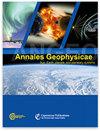Quadratic Magnetic Gradients from 7-SC and 9-SC Constellations
IF 1.9
4区 地球科学
Q3 ASTRONOMY & ASTROPHYSICS
引用次数: 0
Abstract
Abstract. To reveal the dynamics of magnetised plasma, it is essential to know the geometrical structure of the magnetic field, which is closely related to its linear and quadratic gradients. Estimation of the linear magnetic gradient requires at least four magnetic measurements, whereas calculation of the quadratic gradients of the magnetic field generally requires at least ten. This study is therefore aimed at yielding linear and quadratic gradients of the magnetic field based on magnetic measurements from nine-spacecraft HelioSwarm or seven-spacecraft Plasma Observatory constellations. Time-series magnetic measurements and transfer relationships between different reference frames were used to yield the apparent velocity of the magnetic structure as well as the components of the quadratic magnetic gradient along the direction of motion, while simultaneously elucidating the linear gradient and remaining components of the quadratic magnetic gradient using the least-squares method. Calculation via several iterations was applied to achieve satisfactory accuracy. The tests for the situations of magnetic flux ropes and dipole magnetic field have verifies the validity and accuracy of this approach. The results suggest that using time-series magnetic measurements from constellations comprising at least seven spacecraft and nonplanar configurations can yield linear and quadratic gradients of the magnetic field.来自 7-SC 和 9-SC 星座的二次磁梯度
摘要要揭示磁化等离子体的动力学,必须了解磁场的几何结构,这与磁场的线性梯度和二次梯度密切相关。估算线性磁梯度至少需要四次磁测量,而计算磁场的二次梯度一般至少需要十次。因此,这项研究的目的是根据九个航天器 HelioSwarm 或七个航天器等离子体观测台星座的磁测量数据,得出磁场的线性梯度和二次梯度。利用时间序列磁场测量和不同参照系之间的转移关系,得出了磁场结构的视速度以及沿运动方向的二次磁场梯度分量,同时利用最小二乘法阐明了线性梯度和二次磁场梯度的其余分量。通过多次迭代计算达到了令人满意的精度。对磁通索和偶极磁场情况的测试验证了这种方法的有效性和准确性。结果表明,利用由至少七个航天器和非平面配置组成的星座的时间序列磁场测量结果,可以得出磁场的线性和二次梯度。
本文章由计算机程序翻译,如有差异,请以英文原文为准。
求助全文
约1分钟内获得全文
求助全文
来源期刊

Annales Geophysicae
地学-地球科学综合
CiteScore
4.30
自引率
0.00%
发文量
42
审稿时长
2 months
期刊介绍:
Annales Geophysicae (ANGEO) is a not-for-profit international multi- and inter-disciplinary scientific open-access journal in the field of solar–terrestrial and planetary sciences. ANGEO publishes original articles and short communications (letters) on research of the Sun–Earth system, including the science of space weather, solar–terrestrial plasma physics, the Earth''s ionosphere and atmosphere, the magnetosphere, and the study of planets and planetary systems, the interaction between the different spheres of a planet, and the interaction across the planetary system. Topics range from space weathering, planetary magnetic field, and planetary interior and surface dynamics to the formation and evolution of planetary systems.
 求助内容:
求助内容: 应助结果提醒方式:
应助结果提醒方式:


